Overview
The article outlines ten effective patient recruitment strategies in Peru for clinical trials, underscoring the critical role of local partnerships, digital platforms, cultural competence, and data-driven insights. These strategies are meticulously crafted to enhance participant engagement and streamline the recruitment process by addressing unique challenges within the Peruvian healthcare landscape. Ultimately, they aim to improve enrollment rates and the quality of clinical research. As the landscape of clinical trials continues to evolve, understanding these strategies becomes increasingly essential for stakeholders aiming to navigate the complexities of patient recruitment.
Introduction
In the dynamic landscape of clinical research, effective patient recruitment represents a critical hurdle, particularly in regions such as Latin America. Organizations like bioaccess® are at the forefront, leveraging over two decades of expertise to adeptly navigate the complexities of local regulations and patient demographics in Peru.
By streamlining clinical trials through innovative strategies, bioaccess® not only accelerates recruitment processes but also enhances the inclusivity of studies. This article explores the multifaceted approaches employed by bioaccess®, including:
- The fostering of local partnerships
- The leveraging of digital platforms
All aimed at overcoming recruitment challenges and ensuring that clinical trials accurately reflect the diverse communities they serve. As the demand for effective medical solutions continues to grow, understanding these strategies becomes essential for advancing the future of healthcare.
bioaccess®: Accelerating Patient Recruitment for Clinical Trials in Peru
The company has firmly established itself as a leader in medical research across Latin America, with a particular emphasis on Peru. With over 20 years of specialized experience in the Medtech industry, the organization excels in optimizing research processes through a profound understanding of local regulations and patient demographics. This expertise significantly expedites patient recruitment strategies in Peru, ensuring that studies are conducted effectively and inclusively, along with the organization’s comprehensive management services for research, which include:
- Feasibility assessments
- Site selection
- Compliance evaluations
- Study setup
- Import permits
- Project oversight
- Reporting
These tailored patient recruitment strategies in Peru adeptly navigate the unique challenges presented by the healthcare landscape in the country. For instance, while research in neighboring countries may necessitate three to four months for authorization, the organization leverages its local ties and regulatory expertise to enhance patient recruitment strategies in Peru, thereby accelerating the speed at which Medtech firms can introduce innovations to the market.
Moreover, insights derived from previous clinical studies underscore the importance of strategic planning and robust support systems to tackle the logistical challenges faced by participants. Implementing these best practices not only enhances overall effectiveness but also improves patient outcomes. As local regulatory frameworks continue to evolve, the company remains committed to utilizing its insights to refine patient recruitment strategies in Peru, ensuring that Medtech firms can adeptly navigate these changes. Thus, bioaccess® emerges as a vital ally for companies striving for successful studies in the region.
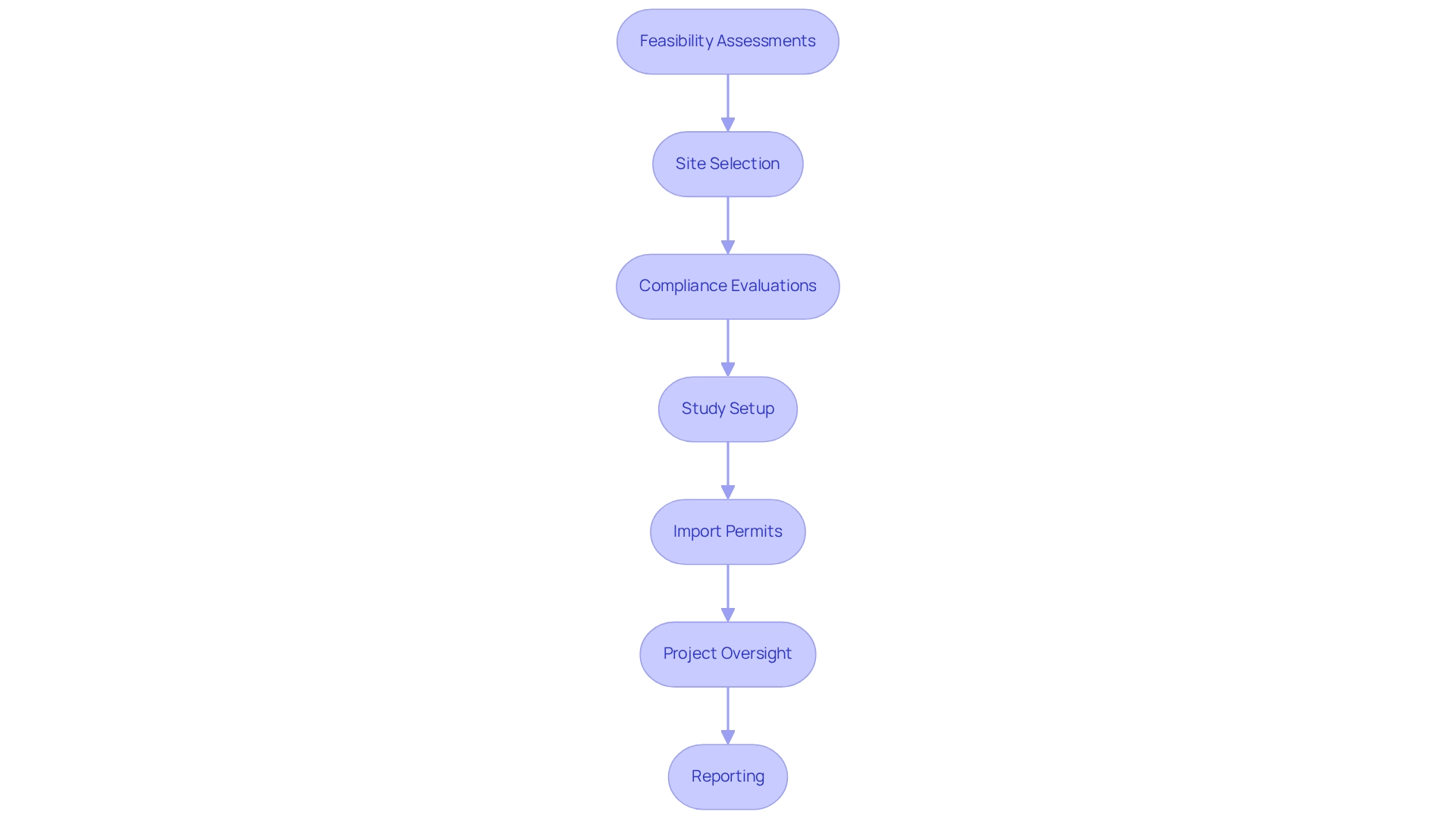
Local Partnerships: Building Trust and Enhancing Recruitment Efforts
Effective patient recruitment strategies in Peru require establishing collaborations with local healthcare providers, community organizations, and patient advocacy groups for research studies. Partnerships like that of bioaccess™ and Caribbean Health Group aim to position Barranquilla as a leading site for research trials in Latin America, supported by Colombia's Minister of Health. Such alliances foster trust and credibility, significantly enhancing the likelihood of potential participants engaging with clinical studies.
By collaborating with local organizations, bioaccess™ can leverage established patient networks and local insights to develop patient recruitment strategies in Peru that resonate with the community's distinct cultural context. Statistics indicate that studies involving hard-to-reach populations benefit considerably from local partnerships, thereby improving participant acquisition effectiveness. Specifically, five studies have shown that targeted hiring initiatives, particularly for minority populations, can create a more inclusive research environment.
Recent webinars highlighted the importance of setting specific enrollment objectives for these groups, which can substantially improve hiring outcomes. Additionally, building trust with local healthcare providers is critical. Engaging community members not only enhances the quality of clinical research interventions but also tackles barriers such as access and awareness, as noted by experts like Darrell M. Gray, II, MD, MPH, FACG. He emphasizes that overcoming these barriers is vital for successful hiring, with local collaborations playing a key role in this endeavor.
By sharing study results with communities, organizations can foster trust and motivate participation in future research initiatives. For example, providing insights on how community contributions shaped the study can enhance transparency and foster a sense of ownership among participants.
This approach not only boosts enrollment rates but also ensures that studies are culturally relevant and significant, ultimately supporting the development of medical devices that can profoundly impact lives. The case study titled 'Innovative Approaches to Enhance Diversity' exemplifies this point, demonstrating that the implementation of focused hiring strategies led to increased involvement from diverse groups, thereby enriching the research landscape.

Digital Platforms: Streamlining Patient Recruitment Processes
Digital Platforms: Streamlining Patient Recruitment Processes
Leveraging digital platforms such as social media, patient registries, and dedicated recruitment websites significantly enhances the patient recruitment process for clinical trials. These tools empower Bioaccess to reach a broader audience, disseminating information about current studies and simplifying the enrollment process. By employing targeted online marketing and producing engaging content, bioaccess® effectively attracts prospective participants who may otherwise remain unaware of available research studies. Moreover, digital platforms facilitate real-time monitoring of hiring metrics, enabling timely adjustments to strategies as needed.
With over half of the global population active on social media, the potential for increased awareness and participation in research studies is substantial, particularly in regions like Peru, where patient recruitment strategies can significantly impact study outcomes. According to Brian Moore, Vice President of NICCA USA, Inc., the research conducted for us has been outstanding. This statement emphasizes the efficacy of bioaccess®'s services in enhancing patient enrollment. Additionally, two-thirds of surveyed locations regard eSource as very or extremely beneficial in clinical trials, underscoring the importance of digital tools in refining participant selection processes.
In the realm of patient enrollment, it is imperative to prioritize data protection and address client concerns. bioaccess® is dedicated to upholding client trust through transparent grievance procedures and adherence to relevant laws. Clients can manage their cookie preferences and gain insight into how their data is processed by consulting our cookie policy and support documents. This commitment to data protection not only streamlines the hiring process but also fosters a trustworthy environment for participants and stakeholders alike.
The competitive landscape is evolving, with key players in the clinical trial technology market increasingly adopting cloud-based solutions and AI to enhance operational efficiency and hiring strategies.
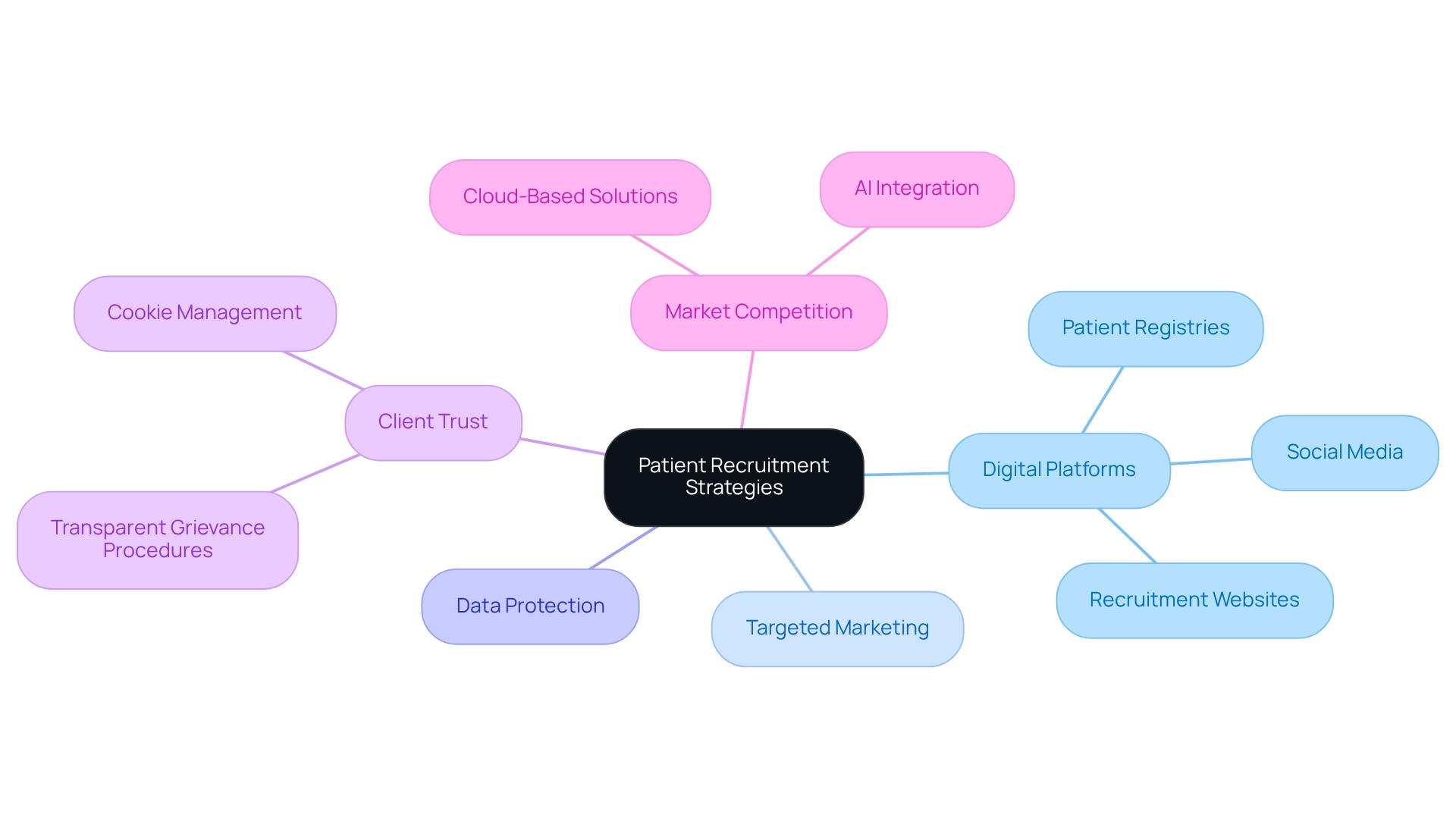
Cultural Competence: Tailoring Recruitment Strategies to Local Communities
Tailoring patient recruitment strategies in Peru to align with the cultural values and practices of local communities is vital for effective patient engagement. The organization prioritizes cultural competence by training its staff to understand and respect local customs, fostering trust and rapport with potential participants. This culturally sensitive method, which is one of the effective patient recruitment strategies in Peru, incorporates relevant messaging and resources that resonate with the target population, significantly boosting participation rates in research studies. By directly engaging with these communities, researchers can build trust and enhance enrollment using patient recruitment strategies in Peru. A study highlighted that while merely 12.6% of lung cancer patients discussed research studies, 15.6% of those were later enrolled, illustrating the potential impact of patient recruitment strategies in Peru that are culturally tailored.
Moreover, this organization provides extensive management services for research studies, including:
- Feasibility assessments
- Site selection
- Compliance evaluations
- Setup
- Import permits
- Project oversight
- Reporting
These services are designed to streamline the hiring process and improve participant retention, particularly emphasizing adherence to regulatory standards and comprehensive reporting of study results.
The partnership between bioaccess® and Caribbean Health Group aims to establish Barranquilla as a leading location for medical studies in Latin America, supported by Colombia's Minister of Health. This initiative not only fosters international collaboration but also contributes to local economic growth through job creation and healthcare improvement. To enhance the effectiveness of this partnership, stakeholders are encouraged to actively engage in community involvement initiatives and share knowledge on best practices. Additionally, incorporating data on diversity is essential for assessing the success of hiring strategies and identifying areas for improvement. As noted by Corbie‐Smith et al., addressing distrust within diverse populations is crucial for enhancing participation rates. Overall, integrating cultural awareness into patient recruitment strategies in Peru enhances engagement and ensures that studies accurately represent the diversity of the communities they seek to assist.

Patient Advocacy Groups: Engaging Communities for Better Recruitment
Patient advocacy groups (PAGs) are instrumental in enhancing enrollment initiatives for clinical studies by informing communities about the benefits of participation. Collaborating with these organizations allows companies to tap into their extensive networks, facilitating more effective outreach to potential participants. PAGs not only aid in disseminating information but also provide critical insights into patient concerns and preferences. This understanding empowers bioaccess® to proactively address issues, fostering a more inviting atmosphere for participation in studies, while engagement with PAGs significantly enhances patient recruitment strategies in Peru. As Ellen Coleman from VOZ Advisors highlights, early collaboration with these groups can mitigate access issues later in the development process. By recognizing PAGs as equal partners, organizations can create treatments that resonate with patient needs, ultimately leading to value-based outcomes. This dynamic partnership evolves alongside the healthcare landscape, ensuring that recruitment strategies remain relevant and effective.
Statistics emphasize the significance of these collaborations; research indicates that effective engagement with patient communities can yield a more diverse participant pool and generate high-quality data, crucial for advancing medical knowledge and improving patient outcomes. Furthermore, community education initiatives have demonstrated a positive impact on participation rates, underscoring the importance of informed and engaged patient groups. Corinna Cornejo from WEGO Health points out that a key consideration in these partnerships is the absence of quid pro quo, highlighting the necessity for authentic collaboration over transactional relationships. Additionally, the partnership between the organization and Caribbean Health Group, supported by Colombia's Minister of Health, illustrates the substantial impact of sustained community involvement in establishing Barranquilla as a leading research hub in Latin America. By leveraging the strengths of PAGs, the organization can refine its patient recruitment strategies in Peru, ensuring that studies are not only successful but also representative of the communities they aim to serve.
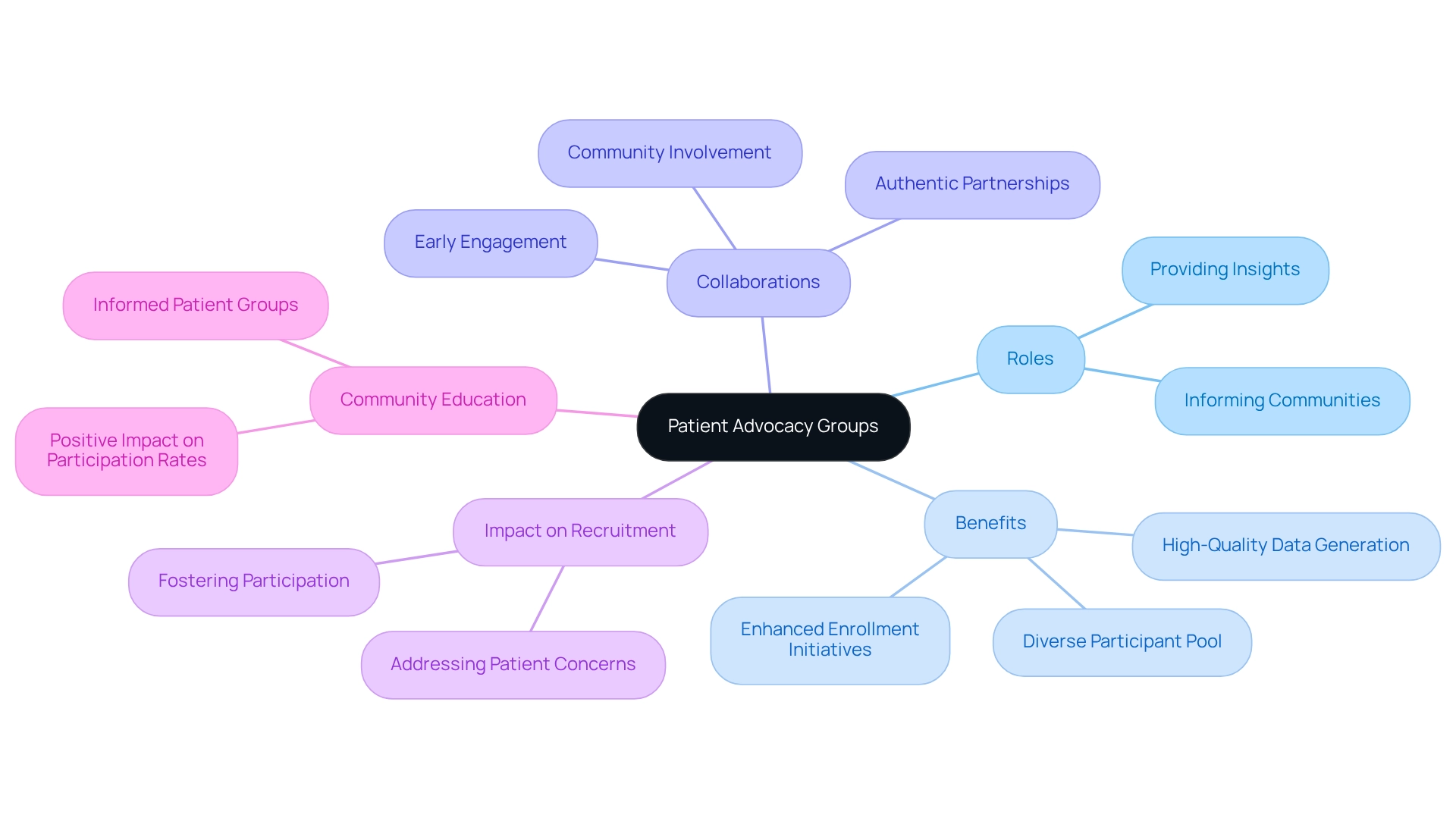
Social Media: Harnessing Online Platforms for Patient Engagement
Social media platforms such as Facebook, Instagram, and Twitter present significant opportunities for engaging potential research participants. By leveraging these platforms, bioaccess® can disseminate informative content, share success stories, and provide updates on ongoing studies. Targeted campaigns designed for specific demographics can effectively raise awareness and generate interest in research studies. For example, data-driven approaches demonstrate that analyzing participant engagement can lead to more effective recruitment strategies, thereby enhancing enrollment conversion rates. A case study titled 'Utilizing Data-Driven Approaches in Clinical Studies' explores how these strategies can yield insights into participant engagement and conversion rates, resulting in improved planning and execution of clinical studies.
Moreover, social media facilitates direct interaction with potential participants, enabling the organization to promptly address questions and concerns, which fosters trust and transparency. This proactive engagement is essential, particularly given that many participants may harbor uncertainties regarding their treatment assignments and the possibility of receiving a placebo. Participants are informed that there is no guarantee they will receive the experimental medication, which can heighten their apprehensions. By effectively utilizing social media, the organization can not only boost awareness of research studies but also cultivate a supportive community surrounding medical investigations.
In collaboration with Caribbean Health Group, the organization is positioning Barranquilla as a leading site for research studies in Latin America, supported by Colombia's Minister of Health. This initiative aims to enhance the recruitment process and retention rates, with GlobalCare Clinical Trials partnering with another entity to achieve over a 50% reduction in recruitment time and 95% retention rates. According to Linda Goler Blount, who is the president and CEO of the Black Women’s Health Imperative, it is important for women to understand that when we refer to something as evidence-based, it means the care standards were designed with their needs in consideration and that they participated in the research process. This statement underscores the critical importance of involving potential participants in the dialogue, further strengthening trust and engagement.
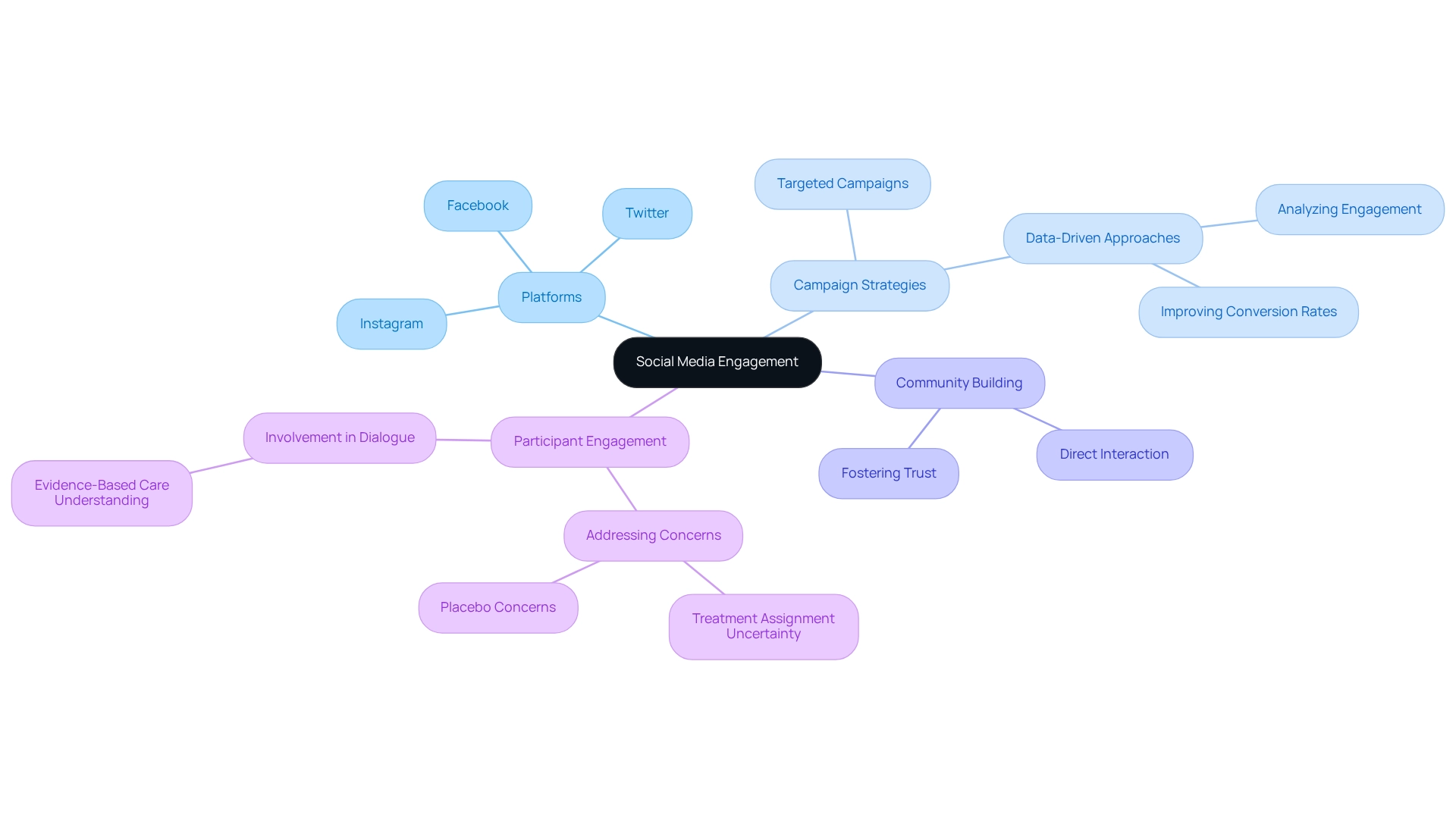
Clear Communication: Highlighting Benefits to Attract Participants
Effective communication is crucial in the implementation of patient recruitment strategies in Peru for attracting participants to clinical studies. bioaccess® prioritizes transparency by clearly outlining the benefits of participation, which include access to innovative treatments, expert medical care, and the chance to contribute to vital medical research. By providing detailed information about the procedure—addressing potential risks and benefits—bioaccess® cultivates trust among prospective participants. This approach is particularly significant in Latin America, where approximately 70% of the population lives over two hours from an academic medical center, which highlights the accessibility challenges that can hinder patient recruitment strategies in Peru.
Case studies have shown that patient recruitment strategies in Peru, including home visits and remote monitoring, can alleviate the burden on patients, especially those with chronic conditions, thereby enhancing enrollment rates. Furthermore, insights reveal that non-white individuals place a higher value on direct communication with trial sponsors, with 82.8% emphasizing its importance compared to 73.8% of their white, non-Hispanic peers. This underscores the need for tailored messaging that resonates with diverse communities to enhance patient recruitment strategies in Peru.
Moreover, the company is dedicated to ensuring information security and client trust through robust data protection measures and a clear grievance process, addressing any concerns in compliance with applicable laws. The organization emphasizes a range of research studies such as:
- Early-Feasibility Studies (EFS)
- First-In-Human Studies (FIH)
- Pilot Studies
- Pivotal Studies
- Post-Market Follow-Up Studies (PMCF)
There is also a recognized need for organizational support in managing communication challenges, along with training courses for study managers to enhance their strategies from initiation to close-out. By applying these efficient communication techniques, the organization can greatly enhance patient recruitment strategies in Peru, leading to improved participant enrollment and retention in clinical studies.

Flexible Trial Designs: Adapting to Patient Needs for Improved Recruitment
Implementing adaptable study designs that prioritize patient needs and preferences can significantly enhance patient recruitment strategies in Peru, especially within the context of Latin America. bioaccess® promotes adaptive study designs that enable adjustments based on real-time data and participant feedback. This adaptability may involve modifying eligibility criteria, study locations, and even the duration of participation. Such accommodations not only broaden the participant pool but also foster greater engagement.
For instance, the I-SPY-2 trial exemplifies how adaptive designs can be effectively utilized, employing Bayesian posterior probabilities to refine treatment options based on interim analysis results. This method can be especially advantageous in Latin America, where comprehending local patient demographics and preferences is essential for successful patient recruitment strategies in Peru.
Moreover, with over 20 years of experience in Medtech, bioaccess®'s proficiency in overseeing Early-Feasibility, First-In-Human, Pilot, Pivotal, and Post-Market Follow-Up Studies establishes it as a leader in Medtech research, enhancing the potential for successful patient enrollment.
The partnership between bioaccess™ and Caribbean Health Group to position Barranquilla as a premier location for medical studies, backed by Colombia's Minister of Health, has already demonstrated encouraging results, including a notable decrease in hiring time and improved retention rates.
Present trends suggest that adaptable study designs are increasingly recognized for their potential to enhance patient recruitment strategies in Peru across diverse therapeutic domains, establishing them as a vital approach in medical research.
To effectively implement these strategies, clinical research directors should consider conducting preliminary surveys to gauge patient preferences and customize study designs accordingly.
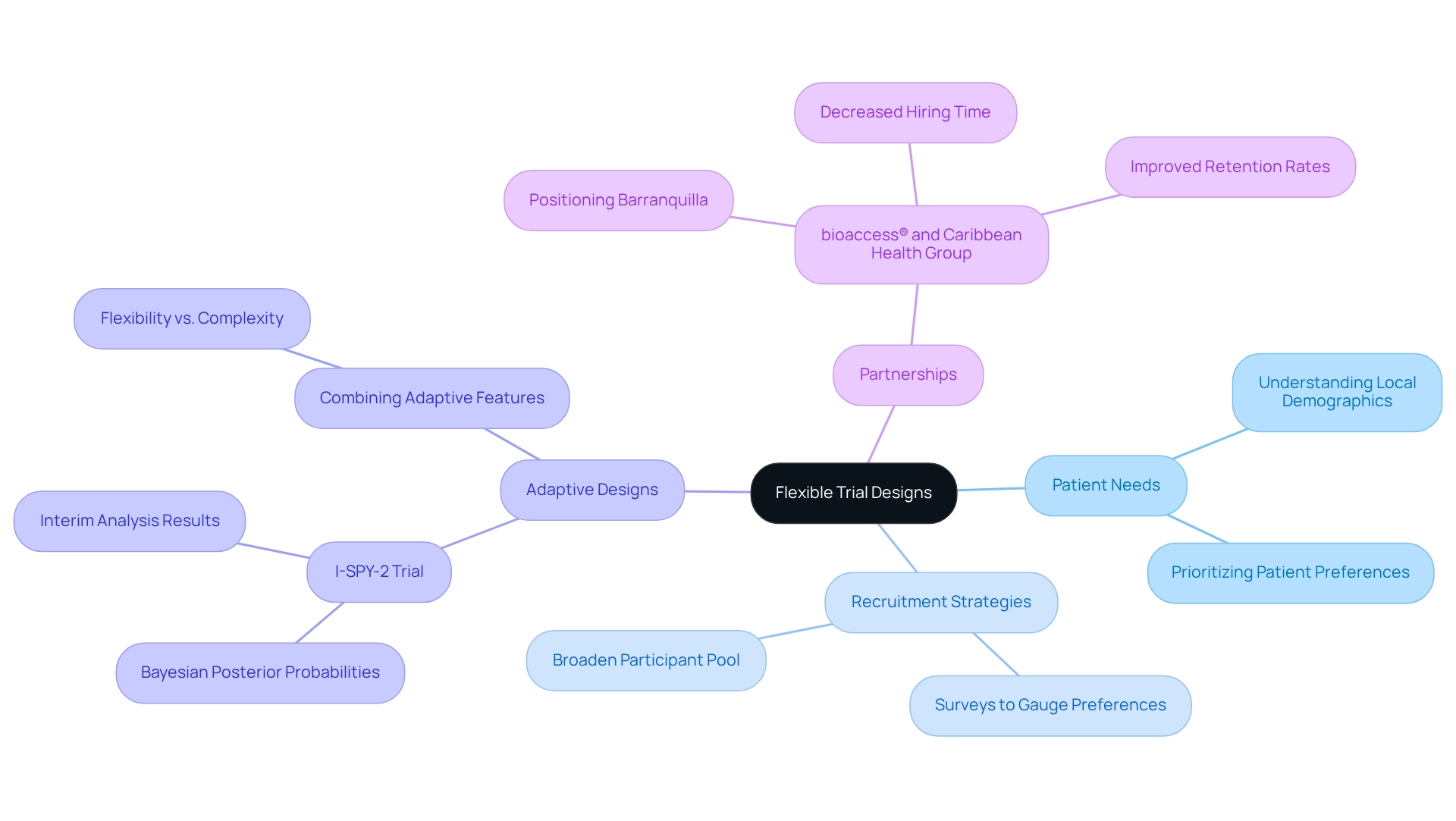
Comprehensive Support: Guiding Patients Through the Recruitment Journey
Providing comprehensive assistance to prospective participants during the selection process is crucial for building trust and encouraging enrollment in patient recruitment strategies in Peru. Bioaccess® employs specialized enrollment coordinators who are readily available to address inquiries, facilitate the enrollment process, and offer continuous support throughout the study. This tailored approach not only alleviates concerns among participants but also ensures that they feel valued and well-informed.
Research reveals that a considerable amount of 'avoidable loss' occurs during patient recruitment and enrollment, emphasizing the necessity for effective patient recruitment strategies in Peru to enhance outcomes. Linda Goler Blount, the president and CEO of the Black Women’s Health Imperative, emphasizes, 'When we refer to something as evidence-based, I want the women I engage with to understand that the care standards were developed considering their needs and that they participated in the research process.' This statement highlights the significance of participant engagement in the research process.
Moreover, findings from a case study indicate that while traditional advertising may not be the primary method for patient recruitment strategies in Peru, social media provides a substantial opportunity for interaction. Additionally, older individuals often have more leisure time, making them more available for participation in research studies.
By fostering a supportive environment and leveraging comprehensive research study management services—including feasibility analyses, site selection, compliance evaluations, study setup, import permits, project oversight, and reporting—bioaccess® ultimately enhances enrollment rates and improves study performance.
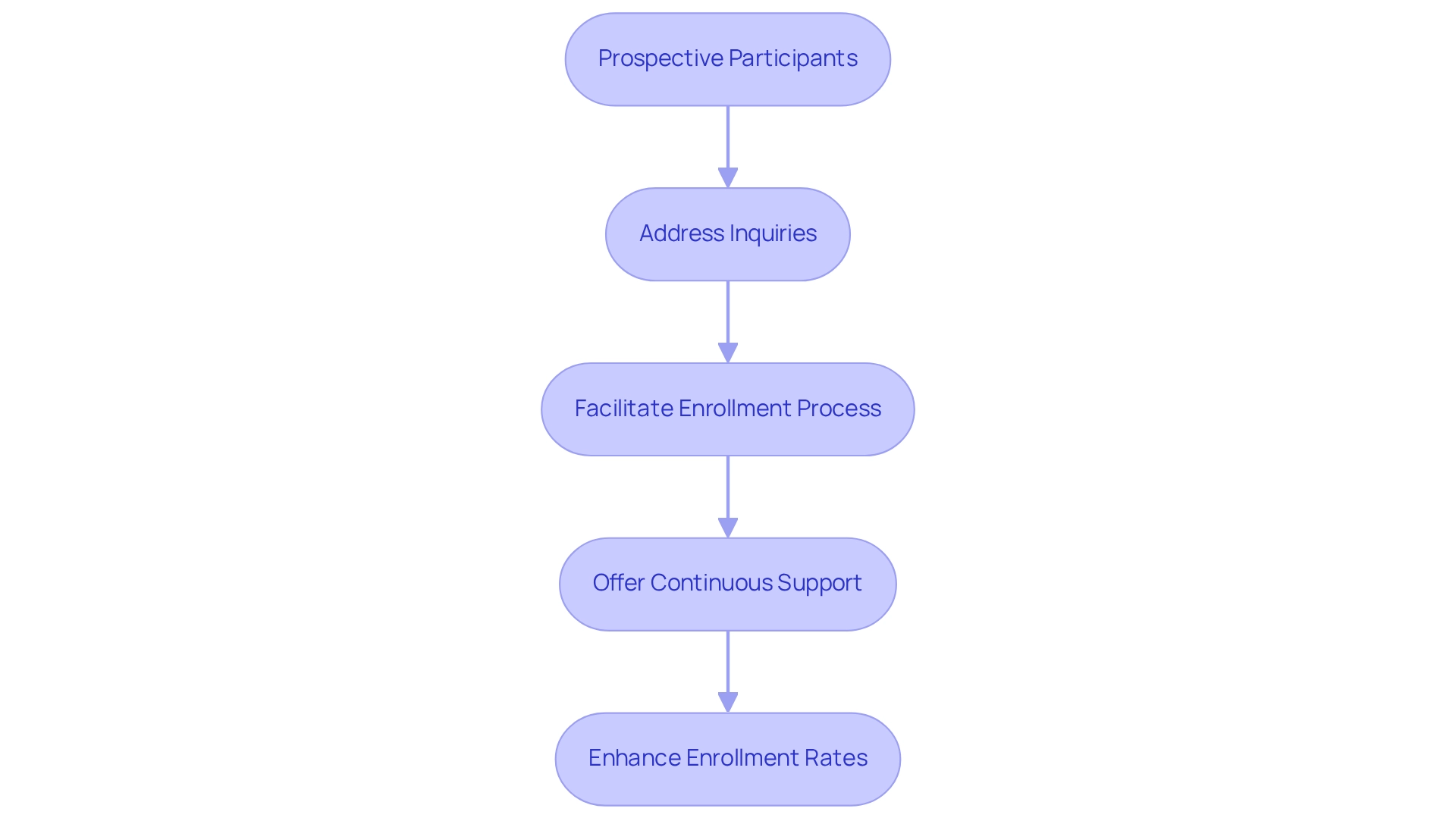
Data-Driven Insights: Optimizing Recruitment Strategies for Success
Employing data-driven insights is crucial for enhancing patient recruitment strategies in Peru within clinical studies. This platform utilizes analytics to track hiring metrics, reveal patterns, and assess the success of different outreach efforts. For instance, data analysis indicates that patients from low-income regions face a travel burden of 58.3 miles for study visits, significantly impacting their involvement compared to only 17.8 miles for individuals from affluent areas. By analyzing this data, the organization can adjust its hiring strategies to address these challenges, ensuring optimal resource distribution and the achievement of hiring goals. This proactive strategy not only improves hiring efficiency but also plays a vital role in the overall success of studies aimed at developing safe and effective products for the entire population.
The partnership between bioaccess® and Caribbean Health Group, supported by Colombia's Minister of Health, aims to establish Barranquilla as a premier location for clinical trials in Latin America, enhancing the landscape for participant acquisition. Upholding ethical considerations, such as ensuring participants' rights and obtaining informed consent, remains a priority, as emphasized in the case study on ethical aspects in future hiring. This commitment strengthens the integrity of hiring strategies.
As Sarah Lee noted, leveraging analytics can lead to a reduction in development costs by 15-25%, highlighting the tangible benefits of data-driven approaches. As the landscape of clinical research evolves, the utilization of analytics will continue to enhance patient recruitment strategies in Peru, ultimately contributing to the development of safe and effective medical products for diverse populations.

Conclusion
The innovative strategies employed by bioaccess® in patient recruitment are transforming the landscape of clinical trials in Peru and across Latin America. By fostering local partnerships and leveraging digital platforms, the organization effectively navigates the complexities of patient demographics and regulatory environments. These collaborations not only build trust within communities but also enhance the inclusivity and diversity of clinical studies, ensuring they reflect the populations they aim to serve.
Moreover, the emphasis on cultural competence and clear communication plays a crucial role in engaging potential participants. Tailoring recruitment strategies to align with local customs and values fosters greater participation and enhances the overall quality of clinical research. The integration of data-driven insights further optimizes recruitment efforts, allowing bioaccess® to adapt strategies based on real-time feedback and demographic trends.
Ultimately, the multifaceted approach adopted by bioaccess® transcends mere acceleration of recruitment; it ensures that clinical trials are accessible, relevant, and beneficial to diverse communities. As the demand for effective medical solutions continues to rise, the commitment to enhancing recruitment processes is essential for advancing healthcare in the region. The ongoing collaboration with local entities and the strategic use of technology positions bioaccess® as a leader in the field, paving the way for successful clinical trials that make a meaningful impact on patient lives.
Frequently Asked Questions
What is the focus of the company in medical research?
The company is a leader in medical research across Latin America, particularly in Peru, with over 20 years of specialized experience in the Medtech industry.
How does the company optimize research processes in Peru?
The organization optimizes research processes by leveraging its understanding of local regulations and patient demographics, which expedites patient recruitment strategies.
What management services does the company offer for research?
The company offers comprehensive management services that include feasibility assessments, site selection, compliance evaluations, study setup, import permits, project oversight, and reporting.
How does the company enhance patient recruitment strategies in Peru?
The company enhances patient recruitment strategies by navigating the unique healthcare challenges in Peru and leveraging local ties to accelerate the authorization and recruitment processes.
What is the significance of local collaborations in patient recruitment?
Collaborating with local healthcare providers, community organizations, and patient advocacy groups fosters trust and credibility, significantly increasing the likelihood of participant engagement in clinical studies.
How do local partnerships improve recruitment for hard-to-reach populations?
Local partnerships allow the company to leverage established patient networks and insights, leading to more effective recruitment strategies for hard-to-reach populations.
What role does community engagement play in clinical research?
Engaging community members enhances the quality of clinical research, tackles barriers to access and awareness, and builds trust, which is critical for successful participant hiring.
How does the company utilize digital platforms for patient recruitment?
The company leverages digital platforms like social media, patient registries, and recruitment websites to reach a broader audience, disseminate information about studies, and simplify the enrollment process.
What are the benefits of using digital tools in clinical trials?
Digital tools enhance awareness and participation in research studies, allow for real-time monitoring of hiring metrics, and enable timely strategy adjustments.
How does the company ensure data protection during the recruitment process?
The company is committed to upholding client trust through transparent grievance procedures and adherence to relevant laws, ensuring a trustworthy environment for participants and stakeholders.




